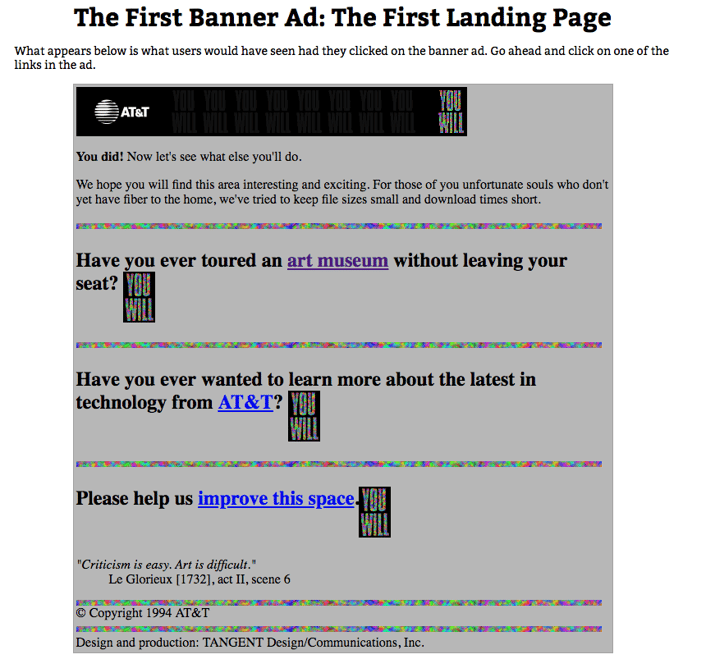It’s been 24 years since AT&T ran its first banner ad on Netscape, and things couldn’t be more different today. Back then, it was all about the bright, broad and in-your-face. Today, the most successful online ad campaigns are more subtle and leverage user demographics and consumer behavior to target the right audience. Let’s take a look at the evolution of the online ad and how it has changed in the last quarter of a century.
The Past: A Timeline of Online Ads
- 1994: The First Banner Ad — The internet’s flagship banner ad debuted on Oct. 27, 1994. It featured a rainbow-colored message that read, “Have you ever clicked your mouse right here? YOU WILL,” which led to the world’s first landing page, promoting AT&T internet access.

Image via the firstbannerad.com.
- The Mid-1990s: The First Pop-Up Ad — You may remember that a few years ago, the inventor of the world’s first pop-up ad, former Tripod designer Ethan Zuckerman, issued an apology for creating one of the web’s most pesky ad forms. The first one appeared sometime in the mid-1990s. The pop-up ad disappeared as quickly as it materialized, as marketers realized it had no real ROI, and browsers began to develop their built-in pop-up blockers.
- 1999: Pay-Per-Click Is Born — By the end of the 1990s, users were regularly relying on search engines to help them navigate the seemingly endless digital world. In 1999, GoTo.com, a search engine that was later bought by Yahoo, invited the first pay-per-click search engine placement model. Google launched AdWords with 350 advertisements in 2000.
- 2003: Social Media Take-Off —MySpace and Facebook, launched in 2003 and 2004 respectively, ushered in a whole new era of advertising for brands, but the rise of social marketing didn’t gain serious steam until Facebook launched its advertising platform, Facebook Ads, in 2007.
- 2010: The Rise of Native Ads — Up until around 2010, ads were reasonably overt — if you saw an ad, you knew it was an ad. Marketers quickly realized that users were savvy enough to tune out ads if they believed them to be irrelevant or of little value, so PR teams began to create ads that integrated more naturally, now known as native ads.
The Now: Native Ads
Right now, we live in a world where the native ad rules. These are online ads that are integrated directly into a user’s line of sight — not in the periphery like banner ads or on another page entirely like pop-up ads. Examples of native ads include sponsored stories on Facebook, promoted tweets on Twitter and sponsored listings on Etsy. Primarily, they have supported elements that are meant to look natural to the page around them, mimicking their style, language and design.
These ads work not only because they’re strategically placed, but also because they’re hyper-targeted and therefore more relevant to a user. Native advertising is one of the most valuable kinds of advertising, and studies show that consumers look at native ads 53 percent more frequently than display ads. They also revealed that 25 percent more people look at in-feed native ads (such as a sponsored Facebook post) versus standard banner ads. Native ads also register a higher boost in purchase intent than banner ads, which may translate into a better ROI.
The Future: Ads of Tomorrow
No one knows how the future of digital advertising will unfold, but we can make some educated assumptions. The first thing we know is that marketers will build upon what’s already working — native ads, personalization and targeting with analytics. Forbes reported that advertisers are already planning to invest significantly more in analytics and advertising insight platforms, so we expect more sophisticated analytics to guide the next generation of marketing.
We’re also hedging our bets on custom native ads, or native ads that are specially developed between a publisher and an advertiser, as well as programmatic advertising, which uses artificial intelligence to handle auction-based ad-buying. We only expect growth and fine-tuning from the technologies that make these ad options possible, so there’s a strong likelihood they’ll be sticking around for the foreseeable future.
The future is unknown, but one thing’s for certain— the eCommerce marketer who stays ahead of the curve is the one who will be the most successful.





